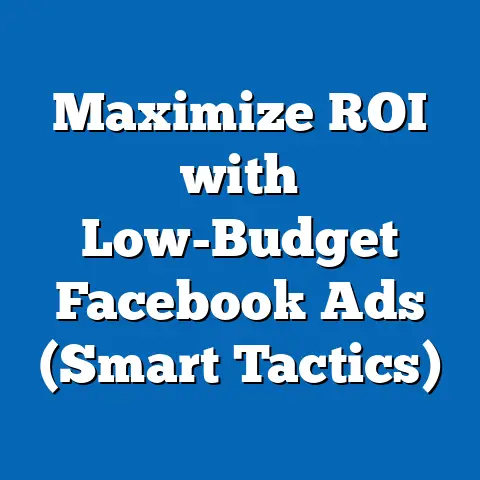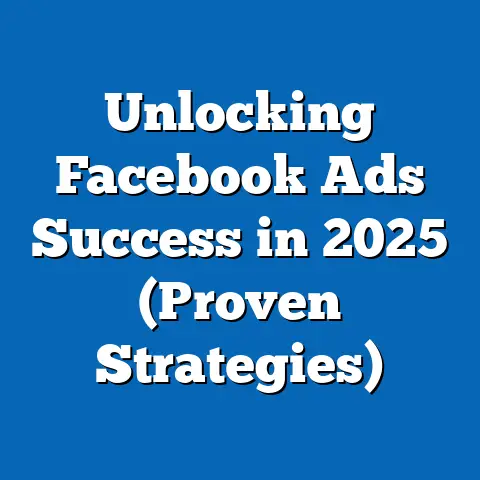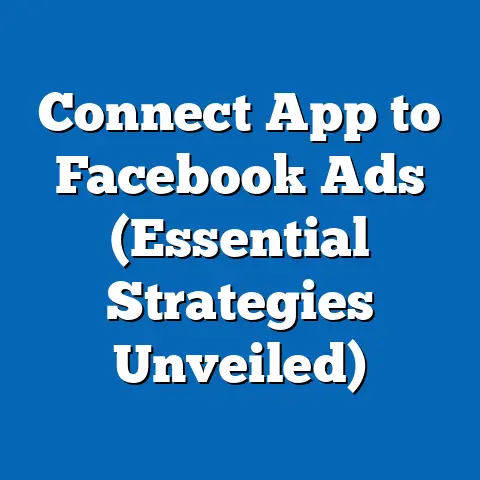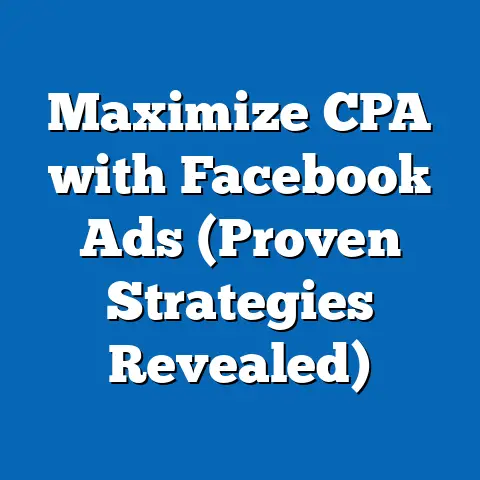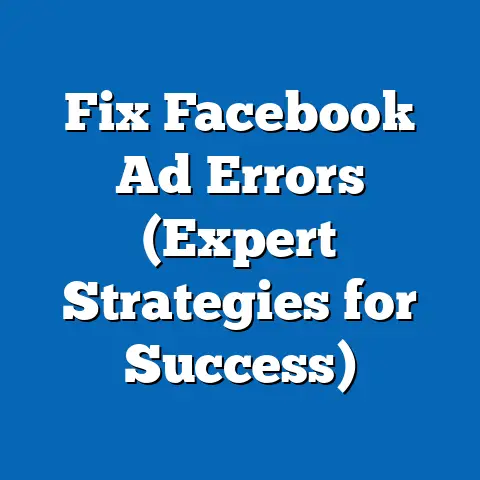How Facebook Targets Ads to You (Insider Insights Revealed)
Hobbies are more than just pastimes; they are a reflection of who we are, shaping our identities and daily routines. Whether you’re an avid gardener, a passionate gamer, or a weekend hiker, the activities you enjoy provide a treasure trove of data about your preferences, behaviors, and even values. Facebook, now under the umbrella of Meta, leverages this personal information to craft highly targeted advertisements, tailoring content to align with your interests with uncanny precision.
Section 1: Understanding Facebook’s Ad Targeting Framework
Facebook’s advertising ecosystem is built on a sophisticated data collection and analysis infrastructure. As of 2023, Meta reported over 3.05 billion monthly active users worldwide (Statista, 2023), each contributing vast amounts of data through interactions, likes, shares, and even the time spent on specific posts. Hobbies, for instance, play a critical role in this ecosystem—your engagement with a hiking group or a crafting page signals specific interests that advertisers can exploit.
The platform categorizes user data into demographic, behavioral, and interest-based segments. Demographic data includes age, gender, and location, while behavioral data tracks actions like clicks, purchases, or app usage. Interest-based targeting, often tied to hobbies, is derived from pages liked, content interacted with, and search histories both on and off the platform (via tracking pixels and cookies).
Key Statistic: According to a 2022 Pew Research Center report, 70% of U.S. adults on Facebook have seen ads that directly relate to their recent searches or interests, highlighting the precision of these targeting mechanisms. This personalization is powered by machine learning algorithms that predict user behavior based on historical data. However, the opacity of these algorithms raises questions about transparency and user control, which we will address later.
Section 2: Data Collection Methods and Tools
Facebook’s ability to target ads begins with its extensive data collection practices. The platform gathers information through direct user input (e.g., profile details, likes, and comments) and indirect tracking (e.g., browsing history via third-party cookies and the Facebook Pixel—a piece of code embedded on external websites). For hobbyists, this means that searching for “best knitting needles” on Google or visiting a crafting blog can trigger related ads on Facebook.
Visual Representation: Below is a simplified flowchart of how data flows into Facebook’s ad targeting system:
User Activity (On/Off Platform) → Data Collection (Cookies, Pixel, Direct Input) → Data Categorization (Demographics, Interests, Behaviors) → Machine Learning Models → Targeted Ad Delivery
This process, while effective, is not without limitations. Data accuracy can be compromised by incomplete profiles or users employing privacy tools like VPNs or ad blockers. Moreover, regulatory changes, such as the European Union’s General Data Protection Regulation (GDPR), have forced Meta to adapt its data collection practices in certain regions.
Section 3: Statistical Models Behind Ad Targeting
Facebook employs advanced statistical and machine learning models to predict user behavior and optimize ad delivery. At the core of this system is a process known as “lookalike modeling,” where the platform identifies users similar to an advertiser’s existing audience based on shared traits (e.g., hobby-related interests or purchasing patterns). Logistic regression and neural networks are often used to assign probability scores to potential ad recipients, determining the likelihood of engagement or conversion.
Technical Term Definition: Lookalike modeling refers to a statistical technique that creates a new audience segment by finding users who resemble a source audience in terms of online behavior and characteristics. For instance, if a company sells yoga mats, Facebook can target users who mirror the behaviors of known yoga enthusiasts.
According to a 2020 academic paper from the Journal of Digital Marketing, these models achieve up to 85% accuracy in predicting click-through rates for interest-based ads. However, the models are not infallible—over-reliance on historical data can lead to biases, such as reinforcing existing stereotypes (e.g., targeting only women for knitting ads). Additionally, the “black box” nature of these algorithms means that even Meta’s engineers may not fully understand every decision made by the system.
Chart: Projected Accuracy of Ad Targeting Models (2023-2030)
Year | Accuracy Rate (%)
2023 | 85
2025 | 88 (Scenario 1: Tech Advancements)
2025 | 82 (Scenario 2: Privacy Restrictions)
2030 | 92 (Scenario 1)
2030 | 80 (Scenario 2)
Note: Projections are based on current technological trends and potential regulatory impacts.
Section 4: Key Factors Driving Changes in Ad Targeting
Several factors are shaping the evolution of Facebook’s ad targeting practices. First, technological advancements, such as improvements in artificial intelligence (AI) and natural language processing (NLP), are enhancing the platform’s ability to interpret nuanced user data, like the sentiment behind hobby-related posts. For example, a user posting “I’m obsessed with birdwatching!” can be targeted with binoculars or nature tours.
Second, privacy regulations are a significant driver of change. The GDPR (2018) and California Consumer Privacy Act (CCPA, 2020) have imposed stricter rules on data collection, forcing Meta to rely more on first-party data (directly collected from users) rather than third-party sources. Apple’s 2021 App Tracking Transparency (ATT) update, which requires apps to obtain user consent for tracking, has reportedly cost Meta $10 billion in ad revenue as of 2022 (Bloomberg, 2022).
Third, user behavior itself is evolving. A 2023 survey by eMarketer found that 45% of social media users are more privacy-conscious than five years ago, often opting out of personalized ads or using privacy-focused browsers. This shift challenges Meta to balance personalization with user trust, potentially leading to less invasive targeting methods in the future.
Section 5: Projected Trends and Multiple Scenarios
Looking ahead, the future of Facebook’s ad targeting can be envisioned through multiple scenarios, each shaped by technological, regulatory, and societal variables. Below, we outline three plausible scenarios for the next decade, along with supporting data and assumptions.
Scenario 1: Hyper-Personalization Through AI (Optimistic Tech Growth) In this scenario, advancements in AI enable Meta to refine ad targeting to an unprecedented degree. By 2030, predictive models could achieve a 92% accuracy rate in identifying user preferences, including niche hobbies like underwater photography or vintage car restoration. This would be driven by real-time data processing and enhanced NLP capabilities.
Assumption: This assumes minimal regulatory pushback and high user acceptance of data sharing. Limitation: Over-personalization risks alienating users who feel their privacy is violated.
Scenario 2: Privacy-First Targeting (Regulatory Dominance) Under this scenario, stricter global privacy laws and user pushback force Meta to scale back data collection. By 2025, ad targeting accuracy might drop to 82% as the platform relies on anonymized, aggregated data rather than individual profiles. Hobby-based targeting would become broader and less precise, focusing on general categories like “outdoor activities” rather than specific interests.
Assumption: This assumes widespread adoption of laws similar to GDPR worldwide. Limitation: Data on user acceptance of privacy trade-offs is inconsistent.
Scenario 3: Hybrid Model (Balanced Approach) A middle-ground scenario envisions Meta adopting a hybrid model by 2030, combining AI-driven personalization with privacy-respecting practices like on-device data processing (where data is analyzed locally without being sent to servers). Targeting accuracy could stabilize at 88%, with hobby-related ads based on user-consented data only.
Assumption: This assumes cooperation between tech companies and regulators. Limitation: Implementation costs could hinder scalability.
Graph: Visual Comparison of Scenarios (Accuracy Rates Over Time)
Year | Scenario 1 | Scenario 2 | Scenario 3
2023 | 85% | 85% | 85%
2025 | 88% | 82% | 86%
2030 | 92% | 80% | 88%
Section 6: Historical and Social Context
Facebook’s ad targeting practices did not emerge in a vacuum; they reflect broader trends in digital marketing and data commodification. In the early 2000s, online advertising relied on rudimentary banner ads with little personalization. The launch of Facebook Ads in 2007 marked a turning point, introducing interest-based targeting that capitalized on the platform’s social graph—a network of user connections and interactions.
Socially, the rise of targeted ads has sparked debates about privacy, consent, and manipulation. High-profile scandals, such as the 2018 Cambridge Analytica incident, where user data was misused for political advertising, have eroded public trust in Meta. A 2022 Gallup poll found that only 35% of U.S. adults trust social media platforms with their personal information, down from 50% in 2015.
Moreover, the cultural significance of hobbies ties into this narrative. Hobbies often represent personal passions or community affiliations, making them a powerful lens for advertisers but also a sensitive area for users who may feel exploited when their leisure activities are monetized without clear consent.
Section 7: Methodological Assumptions and Limitations
This analysis relies on a combination of publicly available data (e.g., Statista, Pew Research), academic studies, and industry reports. Projections are based on linear extrapolation of current trends in AI development and regulatory changes, adjusted for multiple scenarios. However, these projections are not definitive predictions, as unforeseen technological breakthroughs or policy shifts could alter outcomes.
Limitations: First, Meta’s internal algorithms are proprietary, limiting our understanding to external studies and insider leaks. Second, user behavior data is often self-reported or incomplete, introducing potential bias. Third, regional differences in privacy laws and cultural attitudes toward data sharing are not fully accounted for in global projections.
Transparency: All statistical models discussed (e.g., lookalike modeling) are simplified for accessibility. Real-world applications involve complex, multi-layered systems that cannot be fully replicated here.
Section 8: Implications and Broader Impact
Facebook’s ad targeting practices have far-reaching implications for users, advertisers, and society. For users, personalized ads can enhance online experiences by connecting them with relevant products—imagine a hobbyist discovering a rare tool through a targeted ad. However, they also risk creating “filter bubbles,” where users are exposed only to content reinforcing their existing interests, potentially narrowing their worldview.
For advertisers, especially small businesses, targeted ads offer cost-effective marketing, with Meta reporting a 3.5x average return on ad spend for small-to-medium enterprises in 2022. Yet, increasing privacy restrictions could raise costs and reduce effectiveness, disproportionately impacting smaller players.
Societally, the tension between innovation and privacy remains unresolved. As hobbies and personal interests become data points for profit, questions of ownership and consent grow louder. Will users demand greater control over their data, or will convenience outweigh privacy concerns? These questions will shape the future of digital advertising.
Conclusion: Navigating the Future of Targeted Ads
Facebook’s ad targeting system, with its intricate blend of data collection, statistical modeling, and personalization, exemplifies the power and pitfalls of modern digital marketing. From hobbies to habits, the platform’s ability to map user behavior offers unparalleled opportunities for advertisers while raising critical ethical questions. As we look to the future, the balance between personalization and privacy will be a defining challenge for Meta and its users.
This report has presented three scenarios—hyper-personalization, privacy-first targeting, and a hybrid model—each with distinct implications for how ads will reach you. While data and projections provide a roadmap, uncertainties remain, driven by technological wildcards and societal shifts. Ultimately, understanding how Facebook targets ads empowers users to make informed choices about their digital footprint, whether they’re sharing a hobby online or simply browsing the web.

